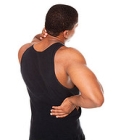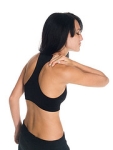Fighting Pain

Stiff Neck:
Workouts can leave your neck feeling a little sore. Soreness usually reduces after 48 hours and is not chronic. If that pain persists, it could be associated with injury and may need medical attention. However, the treatment of neck soreness lies in prevention. Sit and walk straight what the neck and shoulders relaxed.Pull the stomach in. Hold the phone in your hand or go for a blue tooth. A good suggestion is to sleep on a mattress that is not too soft, and a pillow that is not too high. Sitting in front of a computer for hours has its own risks. The muscles in the neck can stiffen and cramp. There are some basic exercises to relieve neck strain, three to four times a day. From a sitting or standing position, move neck forward to back; side to side; flex the neck laterally; and rotate shoulders.
Tip: Shift the shoulder strap of your heavy handbag/laptop frequently from one shoulder to another. Or wear it across to distribute the load across the trunk.

Tootheache:
Dentists believe teeth don’t degenerate overnight. Often, we overlook tell-tale signs of tooth decay like a shooting pain when you bite into an ice cream. Your teeth are composed of different layers. When the top one erodes, the underlying dentin layer can be exposed. Sensitivity is conducted from the dentin layer to the nerve. Immediate pain relief could include rinsing your mouth out with tepid water. If pain persists, try taking an analgesic. Your dentist may recommend desensitising toothpastes if other home remedies don’t prove effective. However, long-term oral hygiene is just as important. Avoid acidic foods and colas which are also high in sugar, another enemy of tooth health. Visit your dentist once in six months so that she can fill up early cavities.
Tip: Tuck a clove or two into your mouth when pain strikes.

Pain In The Upper Body:
If your shoulders, arms or upper back feel strained after a walk it could be because of weak upper-body muscles or due to the excessive swinging of the arms across the body as you walk.
Remedy: Keep the upper body stabilised while the elbows are flexed, in line with the waist and move in a forward and backward rhythm along and by the side of the body. The arms should not move across the body as it neither adds to the walking speed nor ensures a correct posture.
